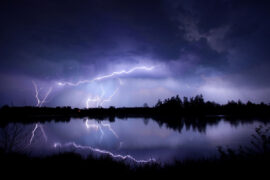Jigging for Lunker Bass
During the winter, many Mississippi sportsmen head to the forests and fields to hunt deer or other game, but they might miss their best chance to land a big largemouth bass. Typically, anglers catch the biggest bass from December through March as females swell with roe before the spring spawn.
In chilly water, cold-blooded bass typically won’t chase baits or prey very far or fast. They tend to hunker down extremely tight to cover such as fallen trees or stumps. When bass turn lethargic in cold water, anglers almost need to hit them on the head to make them bite.
Hard objects such as rocks, concrete blocks, metal poles and wood can absorb some heat from the sun and transmit that warmth into the water. Sometimes, just a temperature change of a single degree could make a difference.
“In winter, I look for areas that are a bit warmer or that have a darker bottom to hold heat a little better,” explained Kevin VanDam, a four-time Bassmaster Classic champion. “Rocks are my favorite choice for cold-weather fishing, but my second choice would be wood. A jig is a good bait to use in an area with a lot of thick cover, such as rocks, stumps or fallen trees.”
Nothing tempts a big Mississippi bass like a succulent crawfish scurrying along the bottom. In the winter, many anglers fish jigs tipped with soft-plastic trailers in brown, red, black or orange colors to mimic crawfish. Toss these around cypress trees or knees growing along the shorelines of the Pearl, Pascagoula and other Mississippi rivers. In tidal waters, a trailer with a black body and blue claws simulates the blue on crab claws.
“Crawfish hide on the bottom,” explained Roger Stegall, a Mississippi bass pro. “When they get disturbed, crawfish jump backwards. That action could attract the attention of a bass. To imitate a crawfish, I hop a jig off the bottom with a series of quick pops and let it fall back.”
Toss a jig as close to a tree trunk, cypress knee or other cover as possible. Let the jig fall on a slack line. Bass often strike as baits sink. When the line stops falling, either the jig hit bottom or something grabbed it. When it hits bottom, slowly drag it out to deeper water. Bumped along the bottom, the jig stirs up a telltale mud trail like a crawfish foraging for food. Work a jig completely around any trees, knees or stumps standing in the water. Fish might hang on one side of cover or another for whatever reason, so always hit the cover from as many different angles as possible.
Don’t expect shoulder-jarring strikes when fishing a jig in frigid water. Sometimes, a bass simply slurps in a jig and may spit it out without the angler even realizing a strike occurred. Also watch the line to see if it moves in an odd direction. Raise the rod to feel the bait. If it feels heavy, set the hook!
In the winter, anglers might not load a boat with bass, but they tend to catch larger fish. Just keep the bait on the bottom or around cover and moving as slowly as possible. One strike could produce the lunker of a lifetime. When in doubt, set the hook!





